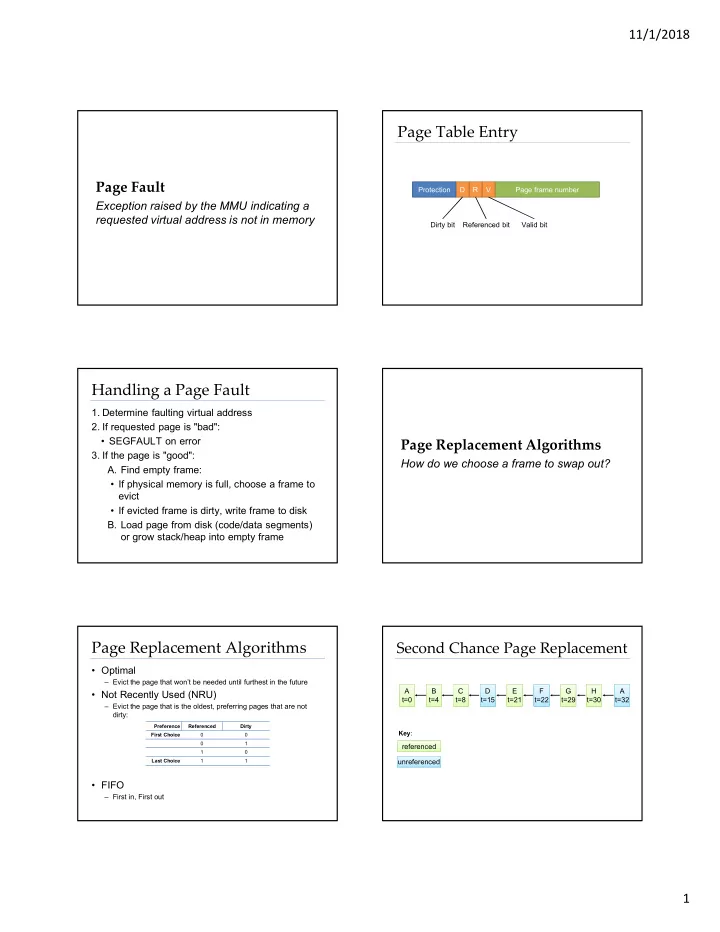

11/1/2018 Page Table Entry Page Fault Protection D R V Page frame number Exception raised by the MMU indicating a requested virtual address is not in memory Dirty bit Referenced bit Valid bit Handling a Page Fault 1. Determine faulting virtual address 2. If requested page is "bad": • SEGFAULT on error Page Replacement Algorithms 3. If the page is "good": How do we choose a frame to swap out? A. Find empty frame: • If physical memory is full, choose a frame to evict • If evicted frame is dirty, write frame to disk B. Load page from disk (code/data segments) or grow stack/heap into empty frame Page Replacement Algorithms Second Chance Page Replacement • Optimal – Evict the page that won’t be needed until furthest in the future A B C D E F G H A • Not Recently Used (NRU) t=0 t=4 t=8 t=15 t=21 t=22 t=29 t=30 t=32 – Evict the page that is the oldest, preferring pages that are not dirty: Preference Referenced Dirty Key : First Choice 0 0 0 1 referenced 1 0 Last Choice 1 1 unreferenced • FIFO – First in, First out 1
11/1/2018 Clock Algorithm A A t=32 t=0 H B B Least Recently Used (LRU) t=30 t=32 t=4 Look to the past to predict the future G C C t=29 t=32 t=8 F D J t=22 t=15 t=32 E Key : t=21 referenced unreferenced Aging Scheme Working Set w(k,t) Referenced Tick 0 Tick 1 Tick 2 Tick 3 Tick 4 this tick Page 0 10000000 11000000 11100000 01110000 10111000 Page 1 00000000 10000000 01000000 00100000 00010000 Page 2 10000000 01000000 00100000 10010000 01001000 Page 3 00000000 00000000 00000000 10000000 01000000 k Page 4 10000000 01000000 10100000 11010000 01101000 Page 5 10000000 11000000 01100000 10110000 11011000 • Working set is the set of pages used by the k most recent memory references • w(k,t) is the size of the working set at time t Working Set Page Replacement Summary Algorithm Comment OPT (Optimal) Not implementable, but useful as a benchmark NRU (Not Recently Used) Crude FIFO (First-In, First Out) Might throw out useful pages Second chance Big improvement over FIFO Clock Better implementation of second chance LRU (Least Recently Used) Excellent, but hard to implement exactly NFU (Not Frequently Used) Poor approximation to LRU Aging Good approximation to LRU, efficient to implement Working Set Somewhat expensive to implement WSClock Implementable version of Working Set 2
11/1/2018 Modeling Page Replacement Belady’s Anomaly Page: 0 1 2 3 0 1 4 0 1 2 3 4 Page: 0 1 2 3 0 1 4 0 1 2 3 4 Youngest page 0 1 2 3 0 1 4 4 4 2 3 3 Youngest page 0 1 2 3 3 3 4 0 1 2 3 4 0 1 2 3 0 1 1 1 4 2 2 0 1 2 2 2 3 4 0 1 2 3 Oldest page 0 1 2 3 0 0 0 1 4 4 0 1 1 1 2 3 4 0 1 2 Oldest page 0 0 0 1 2 3 4 0 1 • FIFO replacement on reference string • Try to reduce the number of page faults by supplying more memory 0 1 2 3 0 1 4 0 1 2 3 4 • Use previous reference string and FIFO algorithm • Add another page to physical memory (total 4 pages) • Page replacements highlighted in orange Local vs. Global Allocation Page Fault Frequency Last access time Page A0 14 Local A1 12 allocation A2 8 A4 A3 5 A4 B0 10 B1 9 Global B2 A4 3 allocation C0 16 C1 12 C2 8 C3 5 C4 4 Page Size • For larger pages – Smaller page tables – Less frames in memory (smaller degree of Page Sharing multiprogramming?) Map multiple pages to a single frame – Internal fragmentation • For smaller pages – Bigger page table – More levels of page tables – Less wasted space 3
11/1/2018 Implementation • Process creation • During process execution When to Write to Disk • Page fault time • Process termination time Now or later? Backing Store I- and D-Spaces Instructions Data 2 32 -1 Data Data Code Code 0 Segmentation 4
Recommend
More recommend